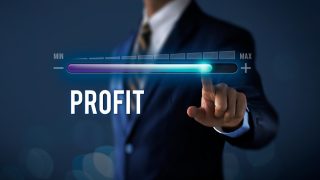The S&P 500 is once again in correction territory now that California has declared an emergency and the coronavirus has spread to 19 U.S. states. I don’t want to say the fear is overdone, but it will be temporary.
For confirmation, we don’t need to look beyond China, where the disease was first identified and where a staggering 780 million people remain under some form of travel restriction. Admittedly, it has been a rough couple of months for Shanghai investors.
But Chinese stocks have not crashed. They dropped 10% and recovered all but a fraction of their lost ground.
Wall Street will follow. I talk about this every week on my radio show. Are you listening? (Click here for recorded episodes and local stations.)
Just Do the Math
More than 80% of all global coronavirus cases happened in China. However, most of the people affected already have recovered. And new infections have dropped below statistical relevance.
You’re now roughly as likely to get hit by lightning in China this year as die from the virus. The outbreak is effectively under control there.
While the disease cycle in the United States is still weeks behind, the trajectory is clear. Unless for some reason our version of the virus is dramatically worse or Wall Street is more fragile than Shanghai, this will be a memory by the end of the month.
In fact, if this plays out like it did in China, stocks have already hit bottom. Shanghai took 35 days to correct after the first coronavirus cases (then simply “pneumonia of unknown cause”) emerged on Dec. 31.
The outbreak spread to the United States on Jan. 19. On the Chinese timetable, we can expect another two weeks of accelerated transmission before new infections level off.
We’ll check in on March 19. At that point, we could see close to 20,000 Americans test positive for the virus, again provided that we use China as our base case.
Of course, every outbreak is different. A U.S. epidemic might top out with five times as many cases as we ultimately see in Italy or eight times as many as show up in South Korea.
On those terms, I won’t even blink unless more than 100,000 Americans catch the disease this season. By that point, a few thousand people across the country may be dead.
That’s far from the end of the world. Those numbers won’t implode the health care system. For Main Street and Wall Street alike, a slightly sicker population simply becomes a fact of life.
Put these numbers in context: 50,000 Americans die of pneumonia every year. Close to a million seek hospital care for that particular disease and are ultimately discharged.
In terms of the math, this is simply a new and vicious form of pneumonia. Hospitals can cope with that. And the economy can cope with that.
The Recovery Clock Keeps Ticking
Epidemiologists have cheered as China keeps coronavirus from spreading to more than 100-200 people a day. Five times as many who were already sick are now healthy again.
At this rate, the world’s biggest population could be statistically virus-free by the end of the month. If the United States follows suit, this will be over for us by early April.
After that, there’s time to perfect a vaccine in the event that this becomes an annual cycle. That’s all right.
Pneumonia vaccines developed in the last two decades have already eliminated close to 600,000 hospitalizations a year. The global population is still getting healthier, not sicker.
Normally, I’m a big biotech booster. The company that ultimately delivers the coronavirus vaccine will make a heroic impact.
But this was a completely unknown disease three months ago. Right now, the field is wide open. Instead of trying to pick a winner, I’m more interested in grabbing the opportunities this correction has created elsewhere in the market.
An investor who bought Shanghai stocks three weeks ago would be up 10 percent today. The underlying economy will weather any shocks from quarantines and factory shutdowns.
Then again, factories throughout China were already hurting from the trade war. A lot of gloom was already built into the macroeconomic models there.
Here in the United States, six weeks after the first coronavirus cases hit the headlines, the job market and the consumer have remained extremely buoyant.
Domestic employers didn’t lay off a lot of people or even cut work hours in February. Instead, 273,000 more people got hired, leaving the unemployment rate at a minimal 3.5 percent.
Now the Federal Reserve has stepped in, flooding the world with even cheaper liquidity. Any company that wanted cash should be able to get it.
Employers should be much more likely to staff up than let people go. An $8.3 billion emergency spending bill will buffer any remaining shocks to the system.
From what I’m seeing in New York City, there’s a lot of talk about being responsible and keeping the infection from spreading. But that isn’t turning into a drag on Main Street.
As remarkable as it might sound, hotels and restaurants are still full. The Apple Store on Fifth Avenue is still open 24 hours a day and it’s full of shoppers after midnight.
This is a metropolitan area where 10 percent of all U.S. coronavirus cases have been reported. It’s far from a ghost town.
If New York plays out anything like China, now is the time to buy the hotel chains on the dip. You might have another few weeks of uncertainty ahead, but Marriott International Inc. (NASDAQ:MAR), Expedia Group Inc. (NASDAQ:EXPE) and the rest of these companies will make shareholders happy at these levels.
I’m also looking at Vornado Realty Trust (NYSE:VNO) in the long term. It’s a great company that owns a lot of blue ribbon New York City retail property. The stock is down 23 percent since reporting earnings three weeks ago.
It will come back. Meanwhile, brace for another few weeks of volatility. In times like this, my 2-Day Trader shines.
Upcoming Appearances:
Join me at the TradersExpo in New York on Monday, March 9, 8-8:45 a.m. EST, for my special presentation, Faster, Stronger, Richer: The Two-Day Trader. Register for free at Kramer.TradersExpo.com and use my priority code of 049072. The event will take place at the New York Marriott at the Brooklyn Bridge. I hope to see you there!




